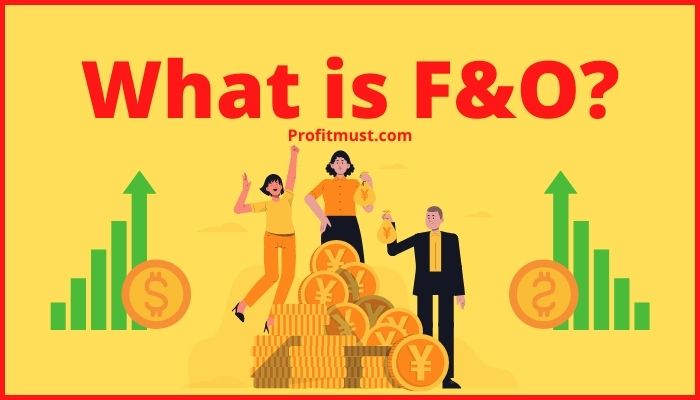Those who trade in the stock markets will understandably be worried about price swings, as variations in pricing might result in losses or gains. They use derivatives like f&o to safeguard themselves. So let’s understand What is F&O meaning with examples & related terms.
Table of Contents
What is F&O?
The f&o full form is Futures and options Which are the most common types of asset derivatives traded on a stock exchange. These are agreements between two parties to trade a financial asset at a later date for a fixed price. By fixing a price ahead of time, these contracts attempt to mitigate market risks associated with share market trading.
In the equity market, futures and options are contracts that draw their price from an actual asset (also known as base), including shares, stock market indexes, commodities, ETFs, and other assets. Investors may use futures and options basics to minimize future risk with their investments by investing at predetermined rates.
What are Futures?
The futures contract is one form of derivative. A bidder (or seller) decides to buy (or sell) a certain amount of a specific item at a defined price at a future date under this form of contract.
Futures are quite useful in reducing the risk of price volatility. A nation that imports oil, for example, will acquire oil futures to protect itself against potential price rises.
Equally, farmers will use futures to lock in prices for their commodities so that they do not have to risk a price drop when it comes time to sell their harvest.

Example
Assume you’ve purchased a futures contract to purchase 50 shares of Xyz Company at Rs 100 per share on a certain date. Regardless of the current market price, you will receive those shares for Rs 50 when the contract expires.
Even if the price rises to Rs 110, you will still be able to buy the stocks for Rs 100 each, resulting in a profit of Rs 1,000. You’ll still have to buy them at Rs 100 apiece if the stock price falls to Rs 90.
If this is the case, you will lose Rs 1,000! Futures are offered on a variety of assets, not only stocks. Futures contracts are available for agricultural commodities, gasoline, gold, and currencies, among other things.
What are Options?
The options contract is another type of derivative. This distinguishes from a futures contract in that it offers a bidder (or seller) the right, but not the commitment, to purchase (or sell) a specific instrument at a specified price on a given date. The call option and the put option are the two main forms of options.
Call Option
A call option is a contract that allows the buyer the right, but not the commitment, to acquire a certain asset at a certain price on a certain date. Let’s assume you bought a call option to buy 50 stocks of Xyz Company at Rs 100 per share on a specific date.
However, the stock price falls to Rs 90 below the expiry period’s conclusion, and you have no interest in completing the contract because you would lose money.
You then have the option of refusing to purchase the shares for Rs 100. As a result, rather than losing Rs 1,000 on the agreement, you will just lose the premium you spent to participate in the contract, which will be far less.
Put Option
The put option is another form of option. You can sell securities at an agreed price in the future under this form of arrangement, but you are not obligated to do so.
For example, if you have a put option to sell stocks of Xyz Company for Rs 100 at a later date and the stock price rises to Rs 110 before the expiry date, you can choose not to sell the stock at Rs 100. As a result, you would have saved Rs 1,000.

F&O meaning in Stock Market
Many individuals are still unfamiliar with stock market futures and options. However, because they have become increasingly popular in recent years, it may be in your best interests to understand more about them.
In the year 2000, the National Stock Exchange (NSE) launched index derivatives on the benchmark Nifty 50. Today, you may buy futures and options on nine major indexes and over 100 different assets.
The Bombay Stock Exchange allows you to trade futures and options (BSE) . The fact that you don’t have to spend cash on the actual asset is a significant benefit of trading in futures and options.
To trade, you simply have to pay an initial margin to the brokerage.
What is f&o trading With Example?
Assume that the profit margin is ten percent. So, if you wish to trade Rs 10 lakh in stock futures, you may do so by paying Rs 1 lakh in margin money to the brokerage.
You have a better chance of generating a profit if you sell in larger quantities. However, if stock prices do not move in the direction you anticipate, you might suffer large losses.
Since you can decide not to exercise your options if prices do not change in the way you predict, there is less risk. The contract’s sole drawback is the premium you’ll have to pay.
So, if you understand what is f&o in the stock market, you can profit from it while lowering your risks.
F&o in Commodities
Commodity f&o are another alternative for investors. Commodity markets, on the other hand, are very volatile, so you should only participate if you are willing to take a significant risk.
Since commodity margins are reduced, there is room for a lot more leverage. Leverage may offer greater earning potential, but it also comes with a larger risk.
Commodity exchanges in India, such as the Multi Commodity Exchange (MCX) and the National Commodity & Derivatives Exchange Limited (NCDEX), allow you to trade commodity futures and options.

Types of F&O Traders
Traders who trade futures and options can be divided into the following categories.
-
Hedgers
These investors use futures and options contracts in the stock market to decrease the risk of price fluctuations in their investments.
Locking in a price for a future transaction might assist people realize relative advantages if the price swings in the opposite direction of a buyer’s trading position.
Individuals who engage into a futures contract, on the other hand, may suffer large losses if the market fluctuates favorably.
An option contract reduces this risk by allowing an investor to exit an agreement if price movements are favorable.
-
Speculators
Speculators forecast the direction of price movement in a market based on intrinsic value and economic conditions, then take the opposite position in the present to profit from price variations.
If a trader believes the price of a futures or options contract will rise in the future, he or she might take a short position in the derivatives market.
It denotes the acquisition of a stock/derivative in the current in order to sell it at a better price at a later period. Investors who predict prices to decline in the future as a result of their market research will hold a long position.
Investors use these contracts to acquire stocks at a lower price in the future, allowing them to benefit in relative terms.
-
Arbitrageurs
Arbitrageurs seek to benefit from price disparities in the market that occur as a result of flaws in the market. The market price and cost of carry are included in a price offered in futures and options trading, as well as the basic expectation that a strike price equals the contractual price.
Carrying the basic security to a future date, indicated as the cost of carry, results in any price difference.
Arbitrageurs, by changing demand and supply patterns to achieve stability, basically eliminate any price disparities originating from faulty trading circumstances.
Conclusion
Futures and options (F&O) are critical to understand because they play a significant financial role in the globe. They contribute to the hedging of price volatility and the maintenance of market liquidity. These derivatives might also be profitable for a clever investor.
This is all from our side regarding what is F&O. Although, if you have any doubts you can just comment below.
Other Interesting blogs related to what is F&O:
Difference Between Futures and Options
FAQ About f and o meaning
What is F&O trading Zerodha?
F&O Trading in Zerodha is trading the Futures and options in stock market via Zerodha.
What is F&O Trading in Hindi?
फ्यूचर्स एंड ऑप्शंस (एफएंडओ) स्टॉक एक्सचेंज में कारोबार किए जाने वाले सबसे आम प्रकार के एसेट डेरिवेटिव हैं। ये दो पक्षों के बीच एक निश्चित मूल्य के लिए बाद की तारीख में एक वित्तीय संपत्ति का व्यापार करने के लिए समझौते हैं। समय से पहले कीमत तय करके, ये अनुबंध शेयर बाजार व्यापार से जुड़े बाजार जोखिमों को कम करने का प्रयास करते हैं।
F&O Meaning in Hindi?
फ्यूचर्स एंड ऑप्शंस (एफएंडओ) स्टॉक एक्सचेंज में कारोबार किए जाने वाले सबसे आम प्रकार के एसेट डेरिवेटिव हैं। ये दो पक्षों के बीच एक निश्चित मूल्य के लिए बाद की तारीख में एक वित्तीय संपत्ति का व्यापार करने के लिए समझौते हैं। समय से पहले कीमत तय करके, ये अनुबंध शेयर बाजार व्यापार से जुड़े बाजार जोखिमों को कम करने का प्रयास करते हैं।
What is f&o ban?
When a stock's futures and options contracts are in the ban period, no new positions are permitted in any of the stock's futures and options contracts. During this time, you will only be able to quit existing positions. Just if the open interest drops under 80% is the ban lifted.
Impact of F&O ban on share price?
An F&O ban on such equities, based on whether the market is bullish or bearish, might result in significant losses for bulls and bears who have open positions in the stock. This is because they may be pushed to exit their current futures or options contracts.

